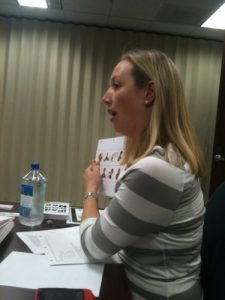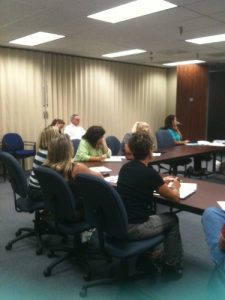 Our July meeting featured guest speaker Liz Mann, a speech language pathologist who has many years of experience working with communication devices and children with special needs. Liz shared her knowledge about how language develops and how this development impacts at what point a communication device might be beneficial for someone who is nonverbal. Liz has worked with and is familiar with low tech communication boards, PECS, Prentke Romich devices, Dynavox devices, Tobii devices, the iPad, and a variety of switches just to name a few.
Our July meeting featured guest speaker Liz Mann, a speech language pathologist who has many years of experience working with communication devices and children with special needs. Liz shared her knowledge about how language develops and how this development impacts at what point a communication device might be beneficial for someone who is nonverbal. Liz has worked with and is familiar with low tech communication boards, PECS, Prentke Romich devices, Dynavox devices, Tobii devices, the iPad, and a variety of switches just to name a few.
She showed a diagram of the hierarchy of symbol set selection, which is used to determine at what stage a person is able to decode symbols– a necessary skill for using a communication device successfully. Having the cognitive ability and skills to understand symbols such as drawings, photographs or words will determine what kind of assistive communication system may be useful for someone.
Liz explained the hierarchy in this way: presymbolic communication (gestures, eye gaze, purposeful moving to object), object representation (actual object or miniature item), photographic representation (picture of object or action), picture/drawing representation (line drawing or stick figures), printed words (words representing objects, ideas and actions).
For example, a person who is at the object representation level will not have the skills to use a device with stick figures representing people, objects, and actions, but may be able to indicate wants and needs by walking to an object and picking it up or gesturing to that object. A person who is at the photographic representation stage may be able to utilize picture cards, but not more abstract line drawings or stick figures found in many communication systems. Adults who are at the printed word stage and who later lose the ability to speak due to a stroke or traumatic brain injury may be frustrated by picture symbols and wish to use a communication device featuring pictures with printed words or printed words alone.
The group discussed that many well-intentioned people can easily make the mistake purchasing a communication application for a mobile device that is too complex for a person who is nonverbal. In other words, using a complex communication app with symbols and abstract drawings for a child who is only at the object representation stage will be a frustrating experience for the child and caregivers.
Liz recommended working with a knowledgeable speech therapist to help support the communication and language development of a child. Obtaining an assistive technology evaluation can also be valuable for determining the appropriate device or communication system for someone. Assistive technology evaluations can be requested through school systems and in private clinics or assistive technology labs. Easter Seals Greater Houston is one place that offers comprehensive assistive technology evaluations and follow-up training.
For more resources about language development, communication devices and core vocabulary, please visit: Â http://www.aaclanguagelab.com/other/core-vocabulary
As another example, here is a link to a screen shot of a SpringBoard device with the core language that can help users get the idea how to set up pages of core vocabulary and activity vocabulary:
 http://www.prentrom.com/support/article/018
BridgingApps has identified and reviewed numerous apps that are appropriate for communication at a variety of levels and stages of language development. For more information about these apps, please click the link below:
http://bridgingapps.org/savedscreen/?id=42773
 After discussing communication apps, the group discussed favorite apps and how they were used by the group this month. See the list below:
After discussing communication apps, the group discussed favorite apps and how they were used by the group this month. See the list below:
ABC Food – food words with pictures, sounds and videos for kids. Pam, a kindergarten teacher loves using this app and others by Peapod Labs LLC for teaching beginning sounds.
Word Games for Kids – Futaba –This is a great multi-player game that teachers new vocabulary. It encourages social interaction, social skills, word fun and turn-taking. Fun for siblings and playdates!
Can Knockdown—Fun for visual perception and fine motor. Very simple cause and effect.
Chrome – Sami’s new favorite. Super fast browsing ability on your mobile device and can sign in and sync to multiple devices to continue where you left off.
Answers:YesNo –Cristen loves the ability to create a choice of two pictures (instead of simply a Yes/No button) with or without word labels. She also appreciates the ability to record the word and customize the button color. Great for young children who are beginning to indicate choices purposefully.
My Choice Board –Great app for making customizable choice boards from 1-6 images.
Peekaboo Barn –Fun for cause and effect, especially for very young children. Excellent graphics.
Sound Touch – Fun for cause and effect and for generalization of language concepts. Multiple themes that appeal to children of all ages, vehicles, instruments, animals and others.
Mini Adventures – Animals–A great app that has built-in video clips of animals as well as numerous pictures of each animal, great for generalizing animal names. We love all the Innovative Mobile apps.
Spawn Glow HD –Fun to create color swirls with the touch of a finger.
Inspiration Maps—A favorite mind-mapping application for older kids and adults. It comes with ready-made templates to brainstorm ideas, organize thoughts and turn a brainstorming session into an organized outline. Ideal for those with executive functioning problems, dyslexics, those who need help organizing thoughts and those with anxiety at facing a big project.


Actually, if we\’re using aac correctly to provide aided language stimulation to the child all the time, then representational system is less important, because they\’ll learn to use what they see being used. And whether you use photos or not may depend just as much or more on the nature of the disability, given the complexity of photos.
And, we far more often use a system that isn\’t complex enough – not that it\’s too complex – because then we fail to provide the vocabulary needed to meet ALL communication needs. That\’s my experience.